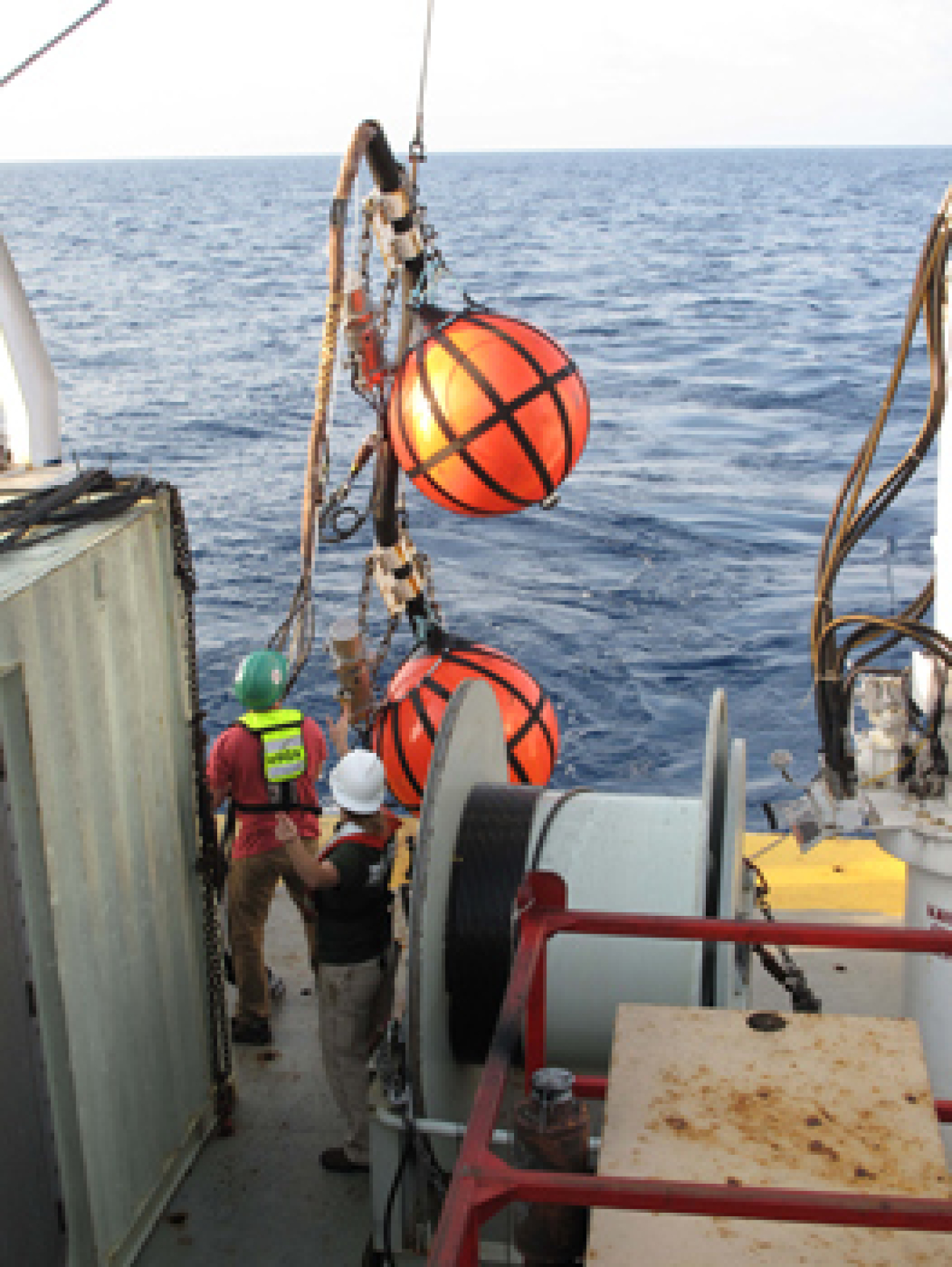A joint-federal-agency 15 day research expedition in the northern Gulf of Mexico yielded innovative high-resolution seismic data and imagery that will help refine characterizations of large methane hydrate resources in the U.S. Outer Continental Shelf.
Hydrocarbons and Geothermal Energy Office
May 14, 2013
USGS technicians Eric Moore and Jenny White deploy instruments at the start of a seismic survey to explore gas hydrates in the deepwater Gulf of Mexico from April to May 2013 | Photo courtesy of USGS
Washington, DC — A joint-federal-agency 15-day research expedition in the northern Gulf of Mexico yielded innovative high-resolution seismic data and imagery that will help refine characterizations of large methane hydrate resources in the U.S. Outer Continental Shelf.
According to the U.S. Department of Energy’s (DOE) Office of Fossil Energy (FE), the information will be used to refine estimates of the nature, distribution and concentration of gas hydrate in the vicinity of 2009 drill sites. Gas hydrates are ice-like substances formed when certain gases combine with water at specific pressures and temperatures, and represent a potentially vast future energy resource.
New data and imagery from the expedition, planned by DOE, the U.S Geological Survey (USGS) and the Bureau of Ocean Energy Management (BOEM) and conducted by the USGS, will also help assess how useful specialized seismic data may be to estimating hydrate saturations in deepwater sediments.
Deposits of gas hydrate are widespread in marine sediments beneath the ocean floor and in sediments within and beneath permafrost areas, where pressure-temperature conditions keep the gas trapped in the hydrate structure. Methane is the gas most often trapped in these deposits, making gas hydrates a potentially significant source for natural gas around the world.
“Understanding the nature and setting of deepwater gas hydrates is central to the National Methane Hydrates R&D Program, which is led by DOE and managed by FE’s National Energy Technology Laboratory,” said Christopher Smith, Acting Assistant Secretary for Fossil Energy. “Over the past 8 years, research carried out under this program has resulted in significant advances in our understanding of methane hydrates, their role in nature, and their potential as a future energy resource. This success is largely due to an unprecedented level of cooperation among federal agencies, industry, national laboratories, and academic institutions.”
The recently completed expedition, planned jointly by DOE, USGS, and BOEM, was executed by USGS. Using low-energy seismic sources, USGS scientists collected details about the nature of the gas hydrate reservoirs and about geologic features of the sediment between the reservoirs and the seafloor. The new data also provide information about how much gas hydrate exists in a much broader area than can be determined from standard industry seismic data, which is typically designed to image much deeper geologic units.
“This expedition represents a significant milestone,” said USGS Energy Resources Program Coordinator Brenda Pierce. “The data and imagery provide insight into the entire petroleum system at each location, including the source of gas, the migration pathways for the gas, the distribution of hydrate-bearing sediments, and traps that hold the hydrate and free gas in place. The USGS has a globally recognized research effort studying gas hydrates in settings around world, and this project combines our unique expertise with that of other agencies to advance research on this potential future energy resource.”
The data were collected at two locations in the Gulf of Mexico where the three federal agencies partnered with an industry consortium to conduct a drilling expedition in 2009 . That expedition discovered gas hydrate filling between 50 percent and 90 percent of the available pore space between sediment grains in sandy layers in the subsurface. These reservoirs are expected to be representative of the 6,700 trillion cubic feet of gas that BOEM estimates is housed in gas hydrates in sand-rich reservoirs in the northern Gulf of Mexico.
The high-resolution nature of the data acquired through this interagency project will uniquely inform the BOEM effort to assess the resource potential of gas hydrates on the U.S. Outer Continental Shelf,” said Renee Orr, Chief, Strategic Resources Office, BOEM.
In coming years, DOE, USGS, and BOEM will continue their collaborative investigation of gas hydrates in the northern Gulf of Mexico and other locations across the world.
<p>FECommunications@hq.doe.gov</p><p> </p>

